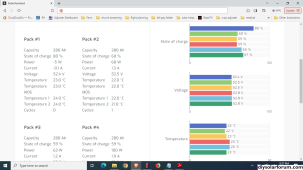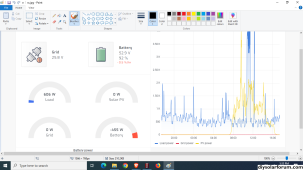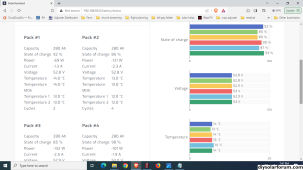I posted this info on another question and a follow up but did not get a reply. I have new info now that hopefully will allow for those smarter than me to answer. On my solar system, I just added three more 48 volt batteries for a total of six, and one of the new batteries charges slowly and discharges slowly. (on the picture, it is the top dark blue bar.) All six are lifepo4 eve 3.2 cell x 16 batteries, giving me two banks of three 16 cell batteries. (that is a total of 96 3.2 cell batteries for clarification) My inverter is a Sol-ark 15K. before adding these last three, one of the first three was a little faster charging and faster discharging than the other two but not that far off. That one (Red on the graph) still charges a little faster and discharges faster than the other two on it's bank but at least it is close. In the attached picture, the top three are the new batteries, and the bottom three are about 4 months older. My bus bars are 4 position bars with the main cable on position 2 while the battery cables are on positions 1,3, and 4. You would think that it is the 4 position battery that might be charging and discharging slower since it is the farthest from the main battery cable, but that is not the case. It is the 1 position on it's busbar. On the other bank, the slightly faster charge and discharge battery is in the 3 position. All cables are the same size and length.

I found that when I isolate the batteries that seem to charge and discharge slower, the wattage is wrong. For example, with only the top battery online, Solar Assistant said that the battery was pulling about 500 watts but my inverter was using about 1000. This was at night with no solar input and is an off grid setup, so power could not be coming from anywhere else. When I isolated each of the other batteries, Solar Assistant said that the battery pull was pretty much matching the inverter load of about 1000 watts. Is this a problem with one of my BMS's? All six are JK B2A24S20P. Does anyone else have an idea as to why this is occurring?

I found that when I isolate the batteries that seem to charge and discharge slower, the wattage is wrong. For example, with only the top battery online, Solar Assistant said that the battery was pulling about 500 watts but my inverter was using about 1000. This was at night with no solar input and is an off grid setup, so power could not be coming from anywhere else. When I isolated each of the other batteries, Solar Assistant said that the battery pull was pretty much matching the inverter load of about 1000 watts. Is this a problem with one of my BMS's? All six are JK B2A24S20P. Does anyone else have an idea as to why this is occurring?




